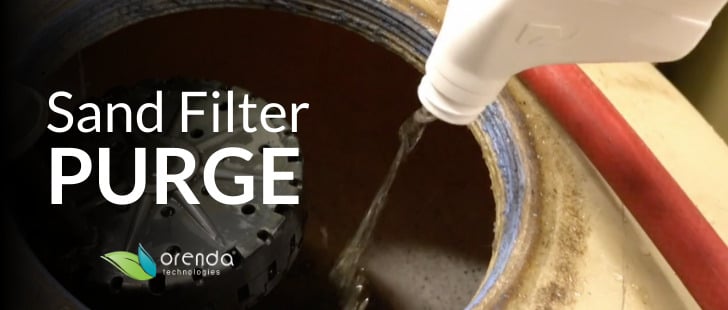Replacing sand in pool filters vs. Refurbishing sand with the Orenda Filter Purge™
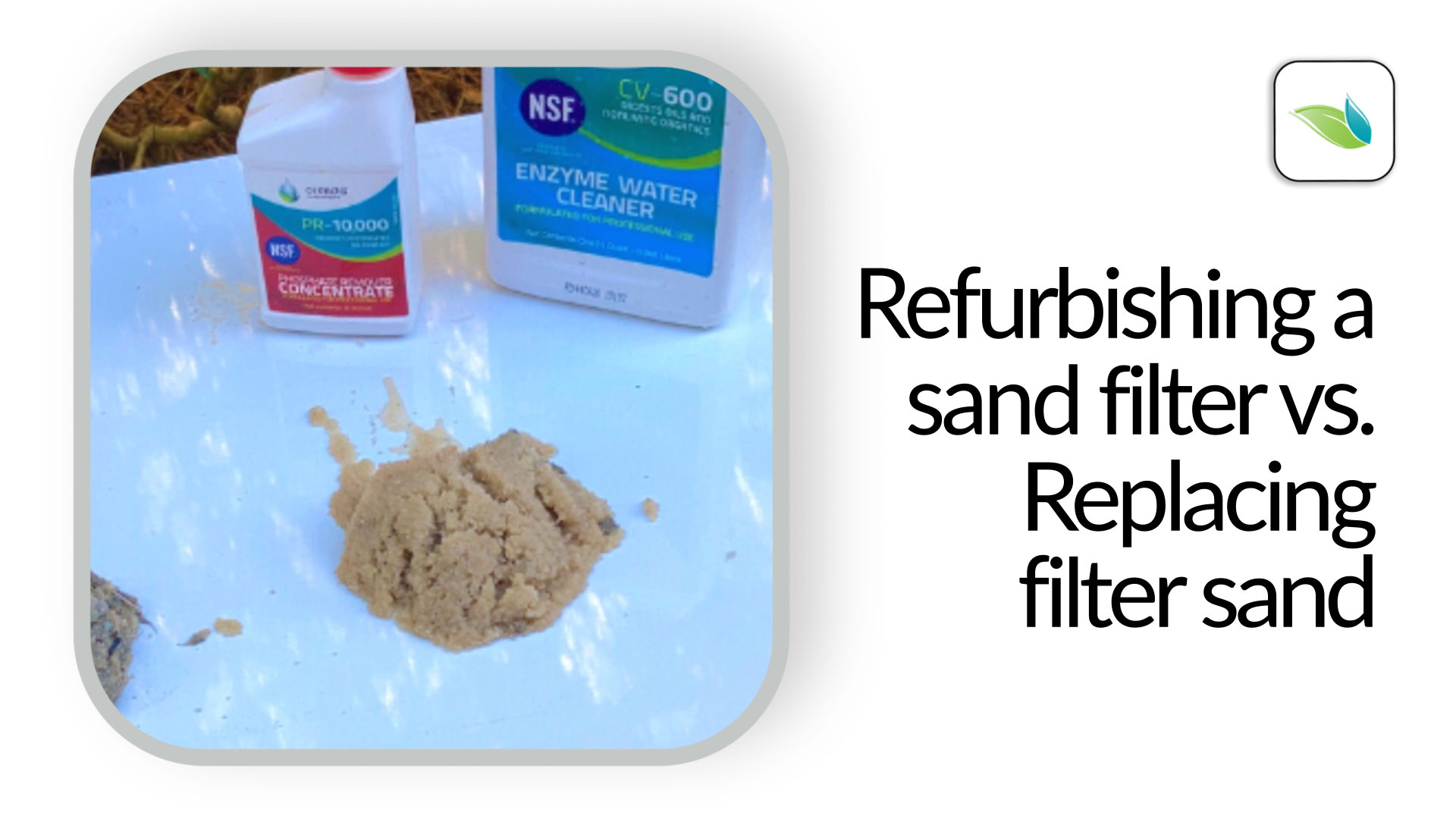
Can a fouled sand filter be cleaned enough that replacing the sand becomes unnecessary? Challenge accepted.
Covered in this article:
- The challenge: a dirty sand filter
- What causes filter fouling?
- How often should you change pool filter sand?
- Does sand wear down in pool filters?
- When should filter sand be replaced?
- The cost to replace sand in a pool filter
- A cost-effective alternative to a sand change: The Orenda Filter Purge™
- Conclusion
The challenge: A dirty sand filter

We were invited to a busy YMCA aquatic center that was getting quotes for a filter sand change. Their vacuum sand filters were over 11 years old at the time, and the sand had never been changed. The sand was oily, sticky, and smelly. The pool water quality suffered, and water clarity was less than desired.
The YMCA had a 300+ member swim team, a masters swim team, and membership programming from learn-to-swim to elderly water aerobics. The pool was heavily used all day every day. On any given weekend, they host events. Some events can have over 700 swimmers using the pool. Suffice it to say, this is a heavily loaded commercial swimming pool, and these filters were taking the brunt of all that bather waste for 11 years. The pool operators were backwashing several times a week, yet the water was consistently dull and cloudy.
In 2017, we were challenged with an opportunity to clean the filter sand with our products, to see if they would do a good enough job to extend the useful life of the filter sand. Nobody––including us at the time––expected the results that followed.
What causes sand filter fouling?
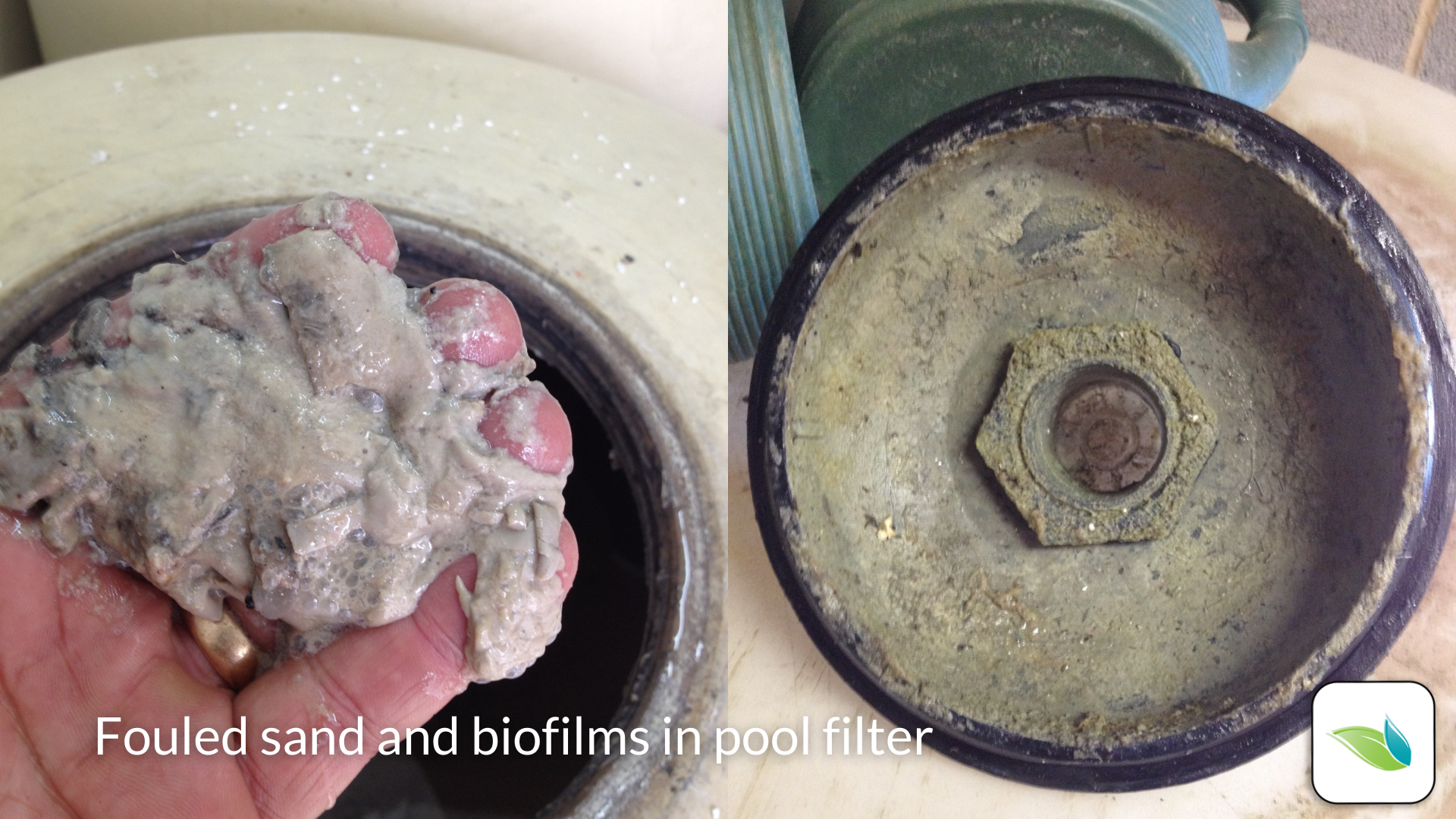
Fouling means the sand is contaminated to a point where normal practices are no longer effective. Simply backwashing a fouled filter will not be enough to restore the original efficacy of the filter. So what causes fouling?
Since 2017, when we first purged and refurbished the sand filter described in this article, we and our customers have purged hundreds, if not thousands of commercial pool sand filters. As we write this update, we can confirm that every single filter purge we have conducted was loaded with oils and non-living organics of some kind. The sand is always sticky, slimy, and disgusting. So far, there have been no exceptions.
Oils and organics are not the only things that foul sand filters. Calcium carbonate can harden in the filter sand too, if the pool's LSI gets too high. In our experience so far, this type of filter calcification is more common in pools using cal hypo chlorine, and/or pools that maintain over 90 ppm total alkalinity.
Filters can also become fouled from the use of alum-based flocculants and synthetic polymer clarifiers. These products can also congeal in the filter. Another inert contaminant is phosphate removal dust, especially if phosphate removers are added directly into a skimmer or gutter (which is NOT recommended for our PR-10,000 product for this reason).
How often should you replace pool filter sand?
The frequency of sand changes depends on the pool's usage. We know many commercial pool service companies that recommend changing the sand every 10 years, or 12, or 15 years. Until we first purged this YMCA filter, we never doubted the need to change filter sand over time. It seemed like common knowledge that the sand wears down over time. But does it?
Does sand wear down in pool filters?
Many people have told us that filter sand needs to be replaced because "the edges of the sand wear down over time." The implication is that 'rounded-off' sand is less effective at screening particles. So, let's unpack this theory.
First, this theory assumes pool filters create enough friction and water flow to wear down the sand within a decade. There is abundant research focused on soil, sand, and rock erosion. Most of what we could find online concerns rivers and streams and how they transport particles and deposit them over time.1
According to our findings, sand–at least the type found in rivers and streams–requires constant water flow exceeding 20 centimeters per second (20 cm/s).2 The process can take decades, depending on the water velocity and turbidity. That said, when sand gets lifted into suspension, it can flow with water much longer without noticeable erosion. Friction with other sand particles, rocks, or silt can accelerate erosion.
Unlike river or beach sand, filter sand is contained and unable to be moved downstream or out into the ocean. It does not crash into pebbles and rocks at high speeds, and it does not tumble. Filter sand stays relatively stationary, and the friction applied to it is from pool water circulating at a given flow rate. The water velocity in the filter becomes slower than in the plumbing because the surface area increases dramatically when water pushes through a sand filter.
All that being said, water still moves faster than 20 cm/s in most pool filters. So, theoretically, sand can erode...it will just take a long, long time. In our experience, however, we cannot tell the difference between old and new sand after chemically purging and cleaning old filter sand.3 So how long will it take for sand to wear down to a point where it's ineffective for pool filtration? We have no idea.
When should filter sand be replaced?
Regardless of whether sand erodes, there are some circumstances where replacing the sand in a filter is warranted. For instance, if the filter becomes calcified with calcium phosphate or calcium sulfate scale, the sand––and perhaps the entire filter––may need to be replaced. Hopefully, you do not have either of these conditions.
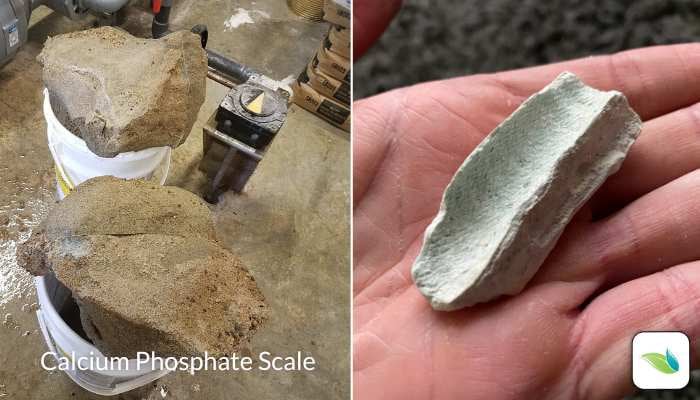
Another reason to replace filter sand is to upgrade to crushed glass media. But apart from a willing upgrade or a type of fouling that chemistry alone cannot resolve, we are not convinced that filter sand needs to be changed during the life of a swimming pool and its equipment.4
The cost to replace sand in a pool filter
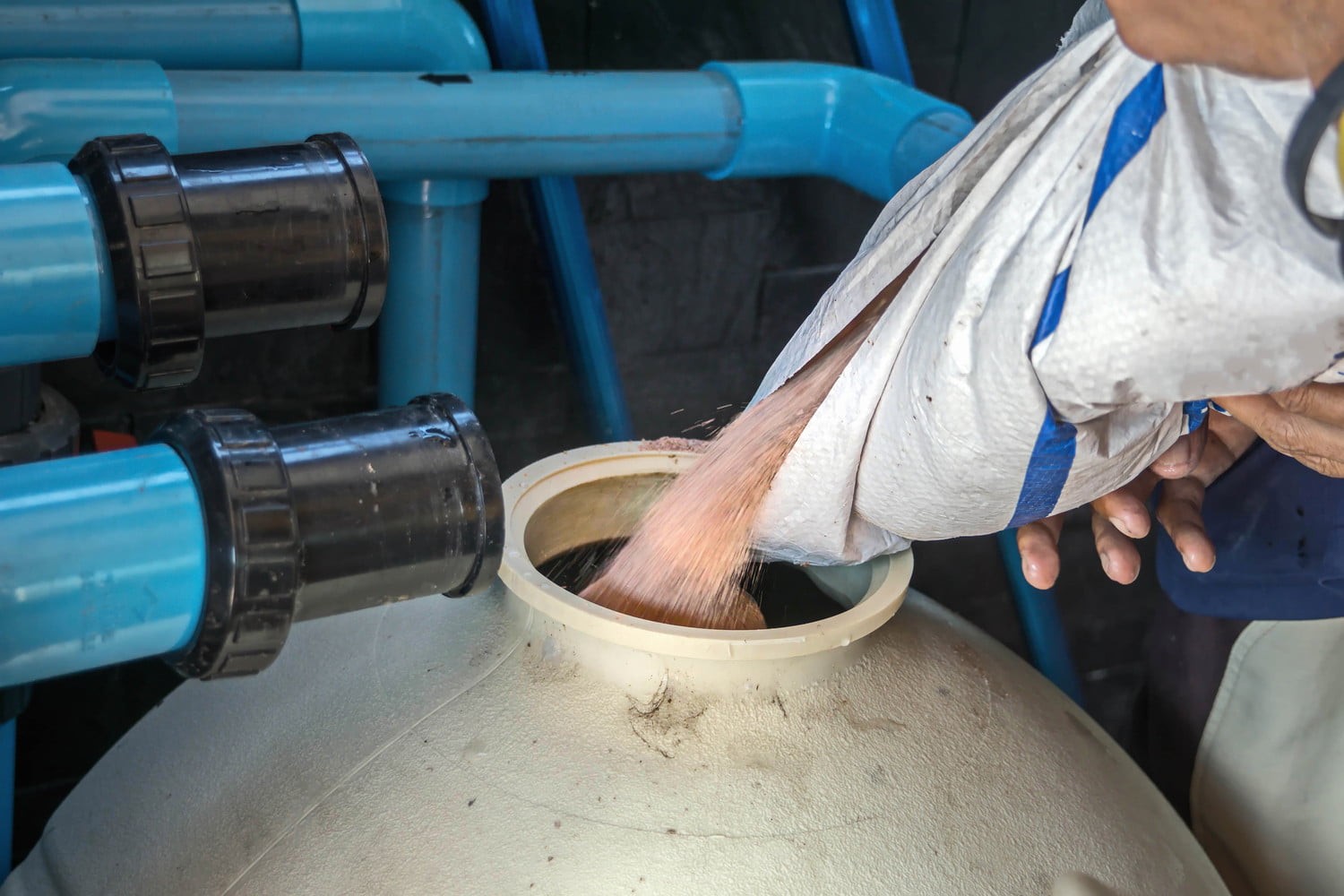
In this case, the YMCA had two large Paddock Vacuum Sand Filters. Their large filter sand beds below grade complicate the sand change process without a commercial vacuum truck. Even so, the estimated cost for the YMCA to replace its sand was $3500. This involved four workers, two days of hard labor, and the cost of the new sand. With inflation since 2017, the same procedure is considerably more expensive nowadays.
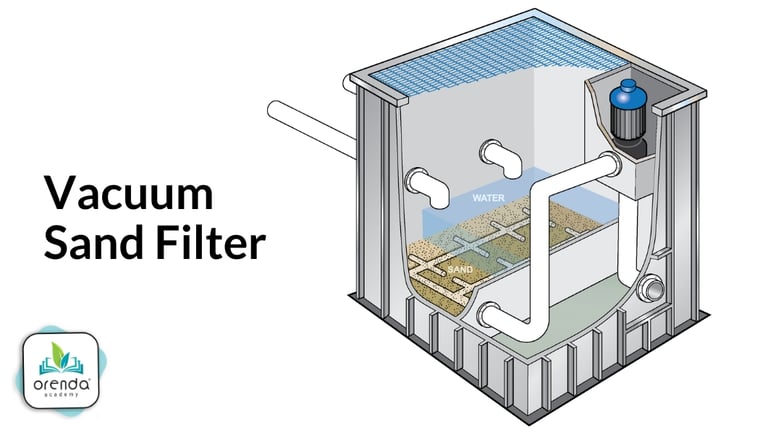
Without a vacuum truck, workers need shovels, wheelbarrows, and buckets to remove and carry the dirty sand to a dumpster. Then, the workers must carry the 50-pound or 100-pound bags of sand back into the pump room to refill the sand beds. In the case of the YMCA, we're talking several thousand pounds of sand per filter.
Smaller filters have less sand, but removing it can be more challenging. Each small scoop of sand must be removed by hand, which can take a long time. The remainder of the sand at the bottom can be pulled out with a shop vacuum, but even that needs to be carried outside and the sand dumped.
Having done sand changes personally, we can tell you it's hard work. And it does not smell good either.
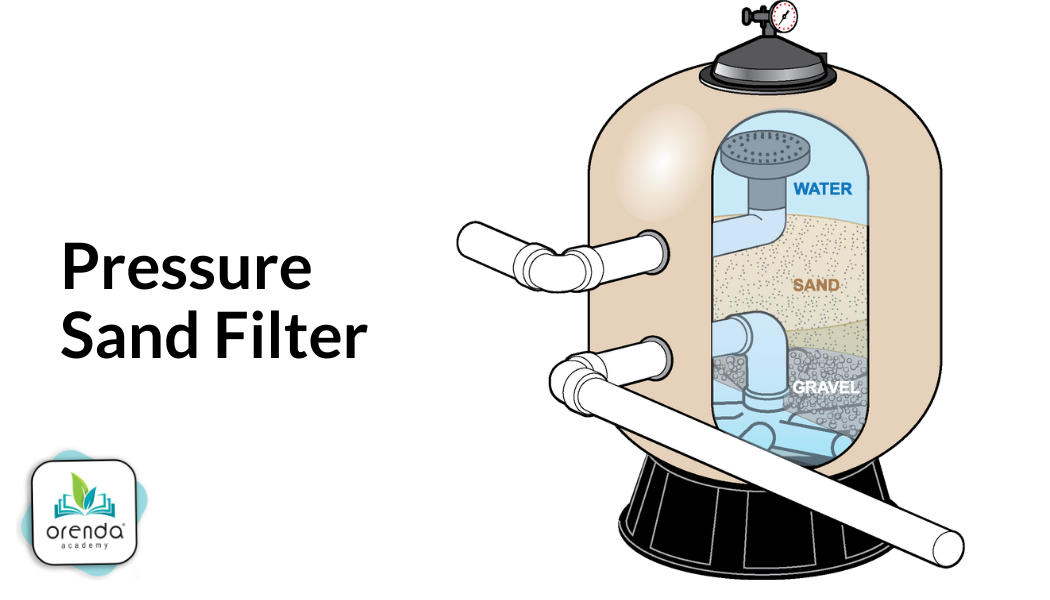
A cost-effective alternative to a sand change: The Orenda Filter Purge™
Instead of changing the sand, we thought we'd try to chemically refurbish the sand by putting a concentrated dose of our CV-600 enzymes and PR-10,000 phosphate remover in the filter. The hypothesis was:
...if we mix our products into this sand bed in a high enough concentration, they can release the non-living organics and other contaminants so they can be backwashed out of the filter, restoring the sand.
Theoretically, if our CV-600 Enzymes are strong enough, they should be able to soak into the sand bed and break down the non-living organic waste (grease, oils, bather waste of all kinds) that acts as a 'glue' in the sand bed. This organic waste clumps sand together and makes it gross.
Since this experiment, we have refined this chemical regiment and learned a few things, as discussed in our step-by-step filter purge procedure.
Dollars and time saved
For seemingly identical results, the Orenda Filter Purge™ procedure is far more cost-effective than changing sand. In the case of the YMCA we first experimented on, this procedure saved them over $3000. As of today, when updating this article in March 2024, they still have not had to replace their sand. It has been purged twice since 2017 and the filter is working fine.
Review our procedure for dosing instructions. The procedure will share the ideal 4:1 ratio of enzymes to phosphate remover. This was discovered through trial and error, and it works well.
We have also introduced a new product into the mix, if you have a particularly bad filter situation. Some of our customers have begun using our SPA-500 pre-drain scrub. SPA-500 contains sodium hydroxide, which helps release and break down even more substances that might be lodged in the filter sand bed. The results have been wonderful.
Conclusion
Chemically cleaning and refurbishing sand has proven to be a viable, cost-effective alternative to changing sand. Yes, there are times when a sand change is necessary, but they are rare. Most filter fouling is from non-living organics and oils, which are sticky and gross and clump sand together. This can lead to filter channeling and cloudy water. It can also lead to biofilm formation, protecting germs from chlorine.
The Orenda Filter Purge™ releases non-living organics from deep within the sand bed and allows them to float up and out of the sand for easier backwashing. The sand looks and feels brand new when it's all said and done. So, if you have a dirty sand filter, consider purging it before replacing the sand itself.
1 Earle, S. (2019). 13.3: Stream Erosion and Deposition. Physical Geology, 2nd Edition. BCcampus.
2 Perera, C., Smith, J., Wu, W., Perkey, D., and Priestas, A. (2020). Erosion rate of sand and mud mixtures. International Journal of Sediment Research. Vol. 35(6), pp. 563-575. https://doi.org/10.1016/j.ijsrc.2020.06.004
3 Since writing this article originally in 2017, we and our customers have purged hundreds of commercial pool filters. There has been no noticeable difference in the quality or texture of the sand. In full disclosure, we have also not sent samples to a laboratory for closer examination. But looking at it with our eyes and feeling it, there appears to be no difference between the 20-year-old sand (in some cases) and brand-new sand out of the bag.
4 We would love to hear from you if you have evidence to the contrary. Photos, microscope images, and any peer-reviewed scientific papers are all welcome. We do not know enough about this yet. We are basing our opinion on our research and the extensive field experience we have earned over the past several years of working with filters.
5 He should probably stick to podcasting.

